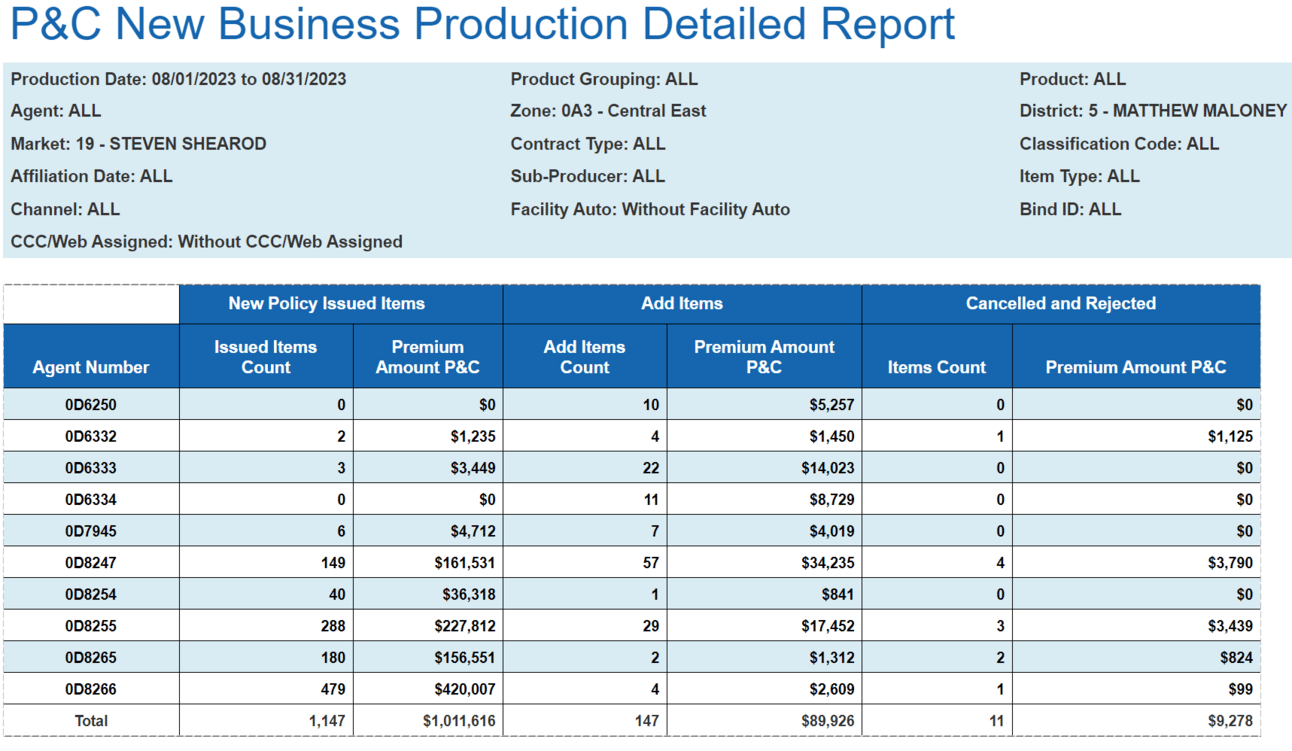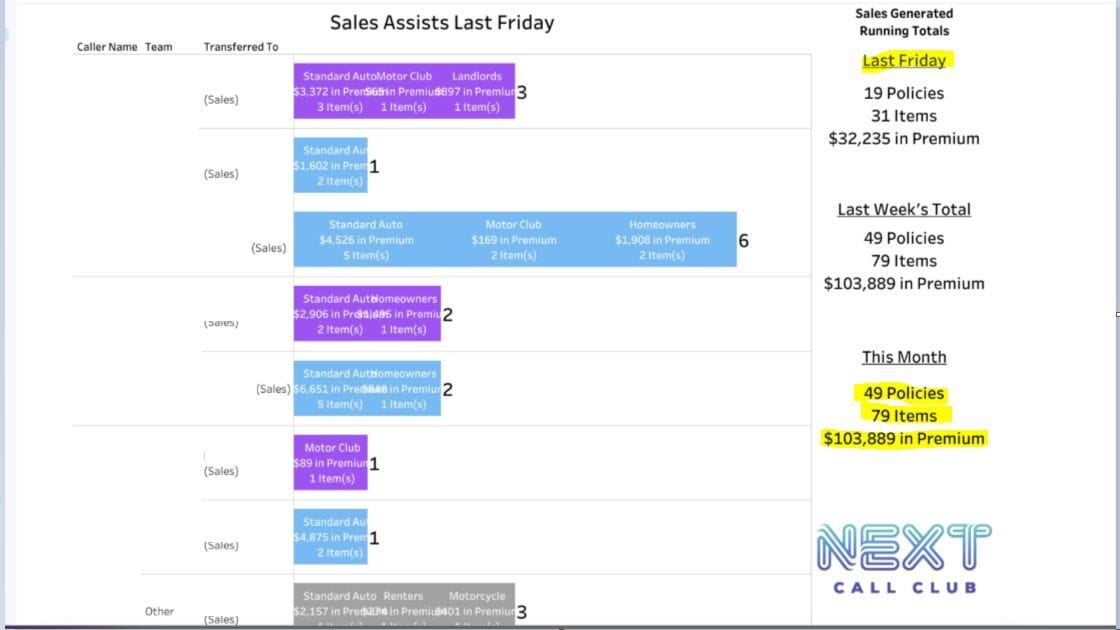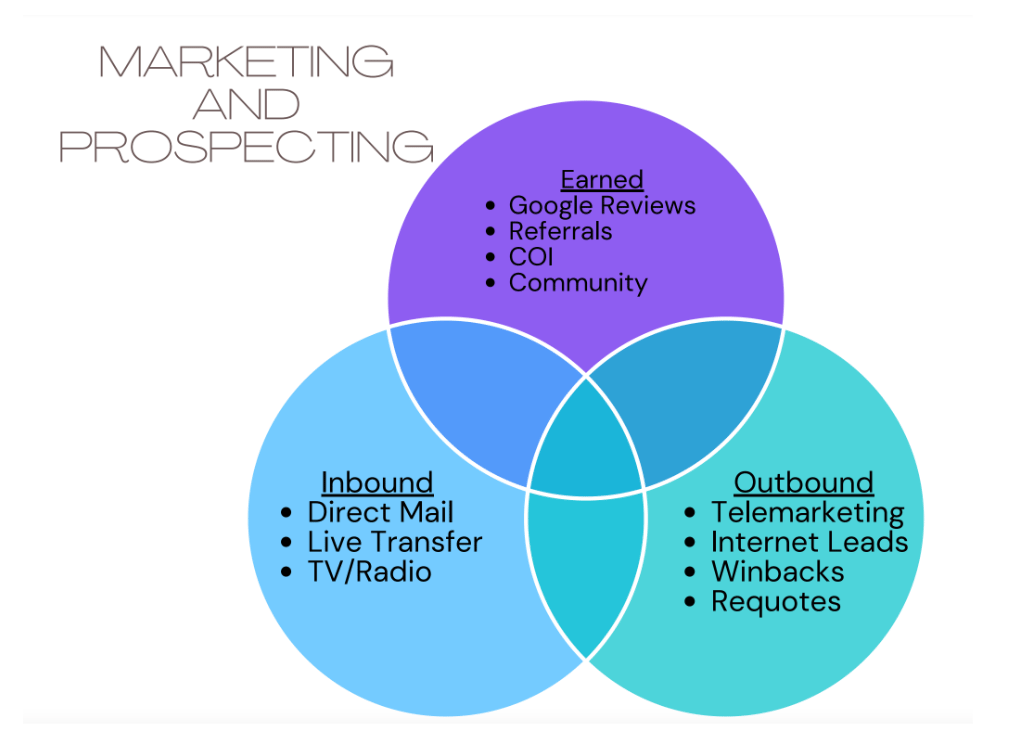
The All Aboard Newsletter
We’re going to break down the marketing behind our 1,147 Items in August, we’ll talk a bit about marketing as a whole, and then we’ll explore how to maximize in-person events.
The next edition will release on Sep 22nd. Given the way the dates fall, we need to skip a week to get back on track for beginning of month NB and mid-month growth.
Lets take a ride!
Reading Time: 9 Minutes

July Results + Breakdown
1,147 Items Sold, $1,000,000+ Written Premium, and $1,600,000 annualized premium.
Three new records for our Sales Team!

We finally broke 1,000 items! Our huge month led us to over $1,000,000 in written premium to boot!
We’ve been chasing the 1,000 item goal for over a year now, but it seems like something always gets in the way.
Last August, we were trending 1,000 items before we lost binding authority for 5 days due to a storm moratorium. We fell short by about 55 items.
Then, the following month we were once again trending 1,000 items, until we took at 25% average auto rate with 1 week to go. We fell short by 82 items
Two months ago, we pushed as hard as possible, but had a ton of PTO the last week of the month. We fell short by only 6 items.
But as we entered August, we were determined not to let that happen again.
We knew that we could face a closure of NB (and we did), and we were locked and loaded with 20 salespeople fully quoting.
We needed to maximize the 23 days we were given.
We explained to our team the opportunity at hand, and the potential landmines.
Our goal wasn’t simply 1,000 items.
We wanted to set new records in every major category.
See, for the last 4-5 months, we’ve been averaging roughly:
850 to 900 items.
Around $750,000 of written premium per month
$1,200,000 of annualized premium per month
Our thought was that we should set a goal well beyond these numbers. That way, if we fall a bit short, we could still land in our 1,000+ territory.
So we set a goal of 1,100 items, $900k Written, and $1,300,000 of annualized premium.

More boats plz
When setting a goal, its important that it is both attainable AND challenging.
Get this mix wrong, and the goal is crappy.
Too easy? People won’t take it seriously.
Too hard? People won’t even try.
1,100 Items felt right because we are finally to 20 people quoting and selling full-time.
Even though 3 of our 20 LSPs were new, we felt confident the team could average 55 items per person.
Furthermore, the math was on our side.
Here is the math on what we needed to do per day to hit our 1,100 item goal:
Closing at 20% → 239 Quotes Per Day
Closing at 21% → 228 Quotes Per Day
Closing at 22% → 217 Quotes Per Day
Equation:
Quotes Needed Per Day = (Item Goal/Item Close Rate)/ # of Days
Given that we had averaged about 220 quotes per day in July, we felt confident that we could hit the 240 quotes per day number if we needed to.
For the last two months, we’ve been closing at roughly 22%, so we knew we had some wiggle room between 217 and 239 quotes per day.
Once the dust settled, we closed at 21% and averaged 236 Quotes per day throughout August.
Simple math says that should end up being about 1,139 items, our actual number was 1,147 with the difference being attributed to a rounding error.
So, as we head into September and the back part of 2023, we have some headwinds we’re facing.
On Monday August 28th, Georgia instituted new RMPs that they’re casually expecting to result in a 30% drop in NB production.
Yesterday, on September 4th, we took a 12.5% rate increase on our home products.
So, it will be a challenge to keep hitting 1,000+ items, but we know how to do the math to get there.
In the meantime, we’'ll continue to focus on building value, increasing our quotes, and asking for referrals to drive New business.
So which marketing sources drove NB?
We often get asked questions likes:
How much do you spend on marketing per month?
What is your best source of marketing?
How do you decide where to invest?
The answers aren’t always simple, but they’re also not complex.
Coming off our best month ever, I thought it would be helpful to break down where our 1,147 NB items came from, show how much we spent on that marketing, and talk about why/how we use the tactics.
Note - You’ll see that I don’t do spend any money on paid live transfers. This is because I can generate them for significantly cheaper ($10-$20 a call) using my in-house caller team through Next Call Club.

Tactic 1: Next Call Club (In House Telemarketing) - 496 Items
I’ve never not had an SDR team.
They are crucial to our sales strategy, and the benefits of having SDRs far outweigh the costs.
SDR stands for “Sales Development Representative.”
While many agents refer to these people as Telemarketers, I choose to refer to them as SDR’s for two reasons:
1.) Nobody aspires to be a telemarketer
2.) Sales Development Representative is industry standard for Tech Sales which many people pivot into after a stint in this role.
In the month of August, we had five full-time SDRs who made outbound calls for our agency.
These are all U.S based employees, and make between $16 and $20 per hour + Daily Bonuses.
When I tell people how this team gets paid, I often hear something like this:
“You pay them how much? They’re just telemarketing! Anyone can do it!!”
And while people might think that is true, it couldn’t be further from the truth.
To be successful at the job, its true that you don’t need experience. But to say that anyone can do it is wrong.
Its a hard and grindy job, but its also one of the most important roles in our agency.
They are the gasoline for the entire sales engine, and they feed the team by accelerating the sales team.
These callers will dial out on three main buckets:
1.) Internet Leads that are 0-90 days old.
2.) Old X-dates/Requotes that we’re targeting based on competitiveness/rate action.
3.) Internet leads we bought over the last 5 years we never contacted (DNC scrubbed of course).
While 80% of the calls they make are on leads, they’ll also call our current book of business for renewals, non-pays, ALR, old leads, requotes, and more.
They’re a mobile assault unit to attack any problem we need to solve.
Having a team that can push thousands of dials per day is competitive advantage many agents simply do not have (but could).
We’re lucky and fortunate to have them.
Our callers have 1 main goal every day:
Send at least 15 live transfers to the sales team per day, with a goal of 20 transfers per day.
So in August, we were seeing roughly 100 Live transfers from the Next Call Club SDR team.
100 Transfers Per Day turns into roughly 170 Quotes per day for the team with a 70% bundled quote rate.

An example of SDR team production. This is from earlier this year and represents 4 days.
All said and done, we averaged a cost per transfer of roughly $11. If we were to add the leads in, it would be around $15 per transfer.
The only reason I don’t add the leads in, is that we would buy them for our sales team regardless of whether or not we had the SDR team.
So 5 callers, almost 100 items generated each.
Not bad!

Leads called by Salespeople - 384 Items
I often get asked if my Sales People are required to call leads and get their own quotes.
Many people think our salespeople don’t dial.
It would make sense to think that, since we have a dedicated outbound calling team right?
But that assumption is wrong. They’re required to dial just like the SDR team is required to dial.
Our salespeople only make about 50-75 calls per day compared to the SDR’s 300+.
We require them to dial because its important to us and our agency culture that people never stop prospecting.
No matter what role you’re in you need to prospect every. damn. day.
We expect our team to get about 14 quotes per day (lines, not households) and we want at least 6 of those quotes to come from the salesperson prospecting for themselves.
This could mean that they call the lead and get a quote, they’ve asked a client for a referral, or they’re working social media to drive their own business.
95% of the time, they get these quotes by dialing leads.
And its a good thing too, because almost 400 items come from quotes that the salesperson calls on themselves.
What we’ve found is that when the salesperson calls themselves, the close rate tends to be about 50% higher (12.2% vs 17.8%).
And while we want our salespeople to call and get their own quotes for this reason, we know for a fact that without the SDR team, we wouldn’t quote half as much business if it was only on the sales team.
The SDR team is an accelerator for an already fast group.
But the truth is, we need to feed the machine a lot of leads.
So, if you’re curious how many leads we buy, we generally use this math:
Number of people calling (SDR + Sales) x 16 Leads per day x # of Days in Month
For us, that number looks like:
25 People Calling Per day (20 sales, 5 SDR) x 16 Leads Per day x 23 Days in August = 9,200 Leads.
We over bought, and often do, but when we want to get a bit more budget conscious, this is the number we fall back to.
We let our leads run 24/7, which sometimes means you over buy. For us though, thats all gravy because our cost-per-item is in a healthy place ($66 across all sources).
So long as the cost per item aligns, we’re very happy.
Between our lead spend ($45,000) and SDR spend ($21,000), we were able to generate roughly 880 items for a cost per item of $77.
We’ll take that all day.
It is important to note though, that we generally try to keep our spend around $38,000 to $41,000 per month on leads.
Given the long month, and some RMP changes that led us to adjusting leads, we over bought by a lot and overspent.
Drips - 82 Items
Drips is a pretty cool company that I’ve been using for a little over a year now.
What they do is take your prospects, and reach out to them via text and via phone for you using AI.
While we’re not allowed to text outside of Hearsay, Drips is able to do it on our behalf.
To be frank, its not cheap.
I pay roughly $5,000 per month, on a 12 month commitment.
It was a $60,000 gamble, but sometimes you gotta take a moonshot right?
(Insert corny All Aboard rocketship pun joke here 😀)
It also took a few months to get the product to work and to train our team on how to maximize it.
Several months to: figure out the right talk-paths, times to contact prospects, when to have Drips start to engage, and more.
But like anything else, the more you iterate, the better you get.
After about 6 months, we started breaking even or posting a profit every single month.
This last month we wrote 82 items off of drips calls, for roughly $80,916 of written premium.
At the 27% average first commission rate, thats $21,821 of revenue and a profit of about $16k.
Not bad right?
So while Drips is quite expensive, the good news is that they’re starting to work with the major captive carriers.
They have pilots out there where the carrier is paying for the service on behalf of their agents, and I’ve talked to several people who are getting the service for free.
So, if you’re curious reach out to your sales leader or I’m happy to tell you more about the service if you’re curious.
Referrals - 63 Items
Referrals have been hot on our tongue lately.
They’re a huge part of our strategy for the remainder of 2023 and through the duration of 2024.
While many agencies use referrals from mortgage lenders, real estate agents, and other local businesses, we’re instead focused fully on customer referrals.
We simply feel its faster to focus on clients for referrals than Centers of Influence.
If you’re able, do both, but since we hadn’t focused on either much, we decided to put our attention on customers.
Our goal is to actively ask our clients for names and numbers that we can call to quote on their insurance needs.
Part of the reason for this huge push is that we’re seeing an item close of 72% YTD.
That means for every 10 quotes we get on referrals, we expect to get 7 items.
That is just absurd when you compare it to the 20% item close we get on internet leads.
To drive activity with our team, we created our “Lifetime Referral Program.”
It works like this:
Every time an LSP gets a referral that they can quote, they get entered into a monthly drawing for a large amazon gift card…. forever.
That means if they get 3 referrals quoted in August, and 6 in September, at the end of the September drawing, they’ll have 9 entries.
This gives an incentive to get referrals in the long-run that adds on to the benefit the salesperson gets by quoting/binding the referral itself.
If you’re still unsure, then think about this.
We spent $500 on this initiative in August, and got 66 items for a cost per item of $8.
These are people who weren’t even shopping.
So now, we’re trying to ask for a referral after every single bind, and every great service interaction.
The image below will show what referrals could do for you and your agency.

20 Referrals a month = $30k in revenue added per year!
Cross-Sells - 31 Items
I’ve written about the importance of cross-sells from our customer service team in previous issues.
Cross-sells will be a massive part of our 2024 strategy to get customer service to cover 50% of their costs.
But to add emphasis, with RMPs tightening all over the country, cross-selling your monoline clients is going to be one of the easiest sales you can make assuming its all on the same company paper.
If your company has a multi-policy discount, you can literally say “You’re missing our single biggest discount, can we check to see if it qualifies?”
Its a slam dunk.
But even if your company doesn’t have the multi-policy discount, many companies now pay better on bundled business than monoline business.
So if people are calling in, ensure that you’re asking, and don’t just stop at the property + auto. Find that third line!
For us, we were able to get about 31 items bound off the cross-sells sent from the customer service team to our sales team.
Our goal in the long run is roughly 50 items from the customer service team, so we have some work to do.
The best part of this though, is that we we didn’t need to spend any additional dollars to generate this business.
It was already there.

Monoline Outbound Calls - 13 Items
This isn’t an impressive number by any means, but we’re happy to see it.
Currently, we have one person working our monoline book for a couple of hours per day.
Given that its such a small part of his day to day, to get 13 items and the revenue that comes with it is a huge win.
In 2024, we’ll have at least 1 person doing this full-time, if not two people.
Right now, we’re laying the groundwork on the strategies and tactics that we’ll use to scale this position.
Testing is so important, and to be able to do it before we really need to crush the goals will be invaluable.
Besides, given how low the breakeven is for this position, its a no brainer.
But by figuring out the process, iterating on it, documenting the processes and ideas, we’ll be able to scale this role quickly when we’re ready.
Its like Abe Lincoln said:
“If I had 24 hours to cut down a tree, I’d spend 23 hours sharpening the axe.”
13 Items may not be a ton, but its all profit, and its helping us build an important set of tactics for 2024 strategic initiatives.
Call-ins - 31 Items
I attribute most of these to our Google Pages and Allstate Pages.
The only “local marketing” we do is our direct mail.
If you’re not pushing hard for Google reviews, you should be. The more reviews you have the better.
There have been studies that show you’re better off have a 3.5 star rating with 400+ reviews than a 5 star rating with 40 reviews.
So if you’re not doing that today, get after it.
Pro-Tip: if you’re making a change to your agency, prepare to lose all your reviews. We changed book numbers and lost 350+ reviews. Now we’re starting from scratch and have a goal of 1,000+ reviews in the next 365 days!
One thing to note about call-ins:
While they’re easy to close, they’re not always the best. We have been running retention by lead source on our book for the last three years, and call-ins have some of the worst retention amongst all sources.
Whether its because they need something right away and take whatever they’re given, or something else, make sure you give these consumers a lot of time on renewals.
Direct Mail - 12 Items
I don’t have too much to write about here.
I’ve not done nearly enough direct mail this year, but I haven’t stopped my monthly bundle mailer that I send out.
As a reminder, we send out a letter to our monoline clients every single month explaining that they’re missing our biggest discount by not bundling.
These 12 items are all from that campaign, and while its not a ton of new business.
The overall campaign cost $1,350. Thats $113 per item.
And while I can’t prove it (yet), I believe that the direct mail reminders make it easier for our customer service team and monoline specialist to cross-sell.
The bundling is no longer a new concept to them.
The customer has seen us mention it at least several times by now.
And given the commission rate on bundled business, the ROI is almost guaranteed to be positive after the first couple items.
I will be ramping up mail for Life Insurance and for Referrals in the coming months.
The idea is the same: Soften up the target audience, so when we ask in person later its an easier yes.
The people who respond to the letter are a bonus, not the end goal.
Thinking about marketing

In general, I like to think about marketing in three buckets:
Inbound (Someone contacts you from an ad)
Outbound (You contact someone via phone, text, email)
Earned (People find you through SEO, Social, Referals, etc)
My goal is to meet people where they are.
People are everywhere.
And I want us to be everywhere (even if its not always the best tactic).
Since I have a large team, budget, and staff, I try to be in all three categories as much as I can.
For too long I’ve over emphasized the outbound piece of this puzzle
That creates a tremendous amount of risk for us.
What if our lead providers go out of business? What happens if spam blockers block all calls?
Ultimately, I want to live in all three buckets equally, but I know it isn’t always realistic.
Its not always a good strategy to be everywhere.
And its ALWAYS a bad strategy to try to do everything in exchange for being a master at something.
My advice is to pick either one of Inbound or Outbound for a majority of your marketing spend then focus on earned at the same time.
Master something first, then build on it.
Once you’ve got enough budget and staff, then add in the third one.
Earned business takes a while to build up, where as live calls, mail, leads etc can all spin up quote volume pretty quickly.
Don’t put all of your eggs in one basket!
For late 2023, and most of 2024, I’ll be working on a few new tactics too.
These include:
Using local facebook groups to get consumers to call us for insurance. (Earned)
Posting content on Linkedin and networking with local business owners for commercial insurance + Benefits (Outbound + Earned)
Investment in content for our website to rank organically on google and bing searches. (Inbound + Earned)
In the meantime, I’m going to stick with whats working.
On my mind this week:
How to maximize your in-person events in the coming months
When I first started going to conferences, trade-shows, expos, and other in person events, I was young and inexperienced.
I was primarily there to learn, and I’d just kind of wander around and see what I found interesting.
I wouldn’t really talk to anyone, and just kind of see where the day took me.
I’d be sure to get to the event first thing in the morning and stay all the way until the end.
I didn’t want to miss anything. After all, we were paying for it, so might as well get our money’s worth right?
And while that worked pretty well, I was really missing out on a lot of the value that these events provide.
Learning is great, but networking and talking about ideas, strategies, and tactics with your peers are even better.
This changed for me after I had gone to the same event a few years in a row.
I realized that most of the information isn’t really new after 1-2 visits.
So I asked myself a question:
“If people have been coming to this event every year for the last 10+ years, what are they getting out if it?”
The answer should have been obvious, but it all clicked one day when I met with one of my vendors who was in town for the show.
He told me “I don’t even buy a pass for the event, I just show up and meet with people.”
If he can get value without even buying a ticket, how much value should I be getting with the ticket to the event?
That mindset changed everything for me in how I approach these events.
Now I go with two main goals in mind:
1.) Meet as many new people as I can while catching up (briefly) with people I already know.
2.) Pick 1 topic to learn about or solution to find BEFORE I go to the event.
For the latter, this is so important.
Your brain will see find you’re looking for.
Ever noticed how when you start looking for a new car, or a new paint color for your house, you see that car or that color everywhere?
Its not a coincidence.
Our brain finds it if we’re focused on it.
So as you go to these events, think about what you’re really struggling with or what you’re hoping to achieve BEFORE you go.
Find a few people on the attendee list you’d love to meet and talk with, then seek them out.
You’ll find the right people, products, services, and solutions that you need if you spend the time to think about it before you go. I promise.
For the former, we all know that networking is valuable.
When I first started networking, I did the comfortable thing, which is what I see most people doing.
They hang out, talk with, and stick close to the people they know.
If your goal is to deepen the relationships with those people, there is absolutely no problem with that at all.
However, if your goal is to meet new people or build on new relationships, talking with people you don’t know is a better tactics.
You also increase your chance to get lucky.
The people you know are a known commodity. We generally have a good idea of what they’re an expert at, who they know, where they stand, etc.
Thats good. Familiarity is a good thing and vitally important. Some of my best friends are peers in the industry.
However, when you talk to new people, you never know what you might learn.
They might have a question that sparks an idea, a person that they can introduce you to (or you them), and perhaps they’re your next partner in a new venture.
The point is, if you don’t meet these new people, your world will only stay as big as it is right now.
Talk to strangers
Ask about them and their business.
Don’t talk about you and your business.
Be curious, add value, and help people however you can.
And if given the opportunity? Introduce them to someone who you think they’d get value out of knowing.
Be a connector!
So in short, before you go to an in-person event for business:
1.) Define the goal you’re trying to achieve by going to this event.
2.) Pick 2-3 people you’d like to meet or ask 2-3 people who they think you should meet.
3.) Focus on Quality, not Quantity of sessions → Don’t burn out by going to every session. One amazing session where you’re engaged is better than 4 sessions where you’re tired.
4.) Write thank you notes after the events to the people you meet. This will make them more memorable to you, and you to them.
If you do these 4 things at every event you attend, I promise you you’ll see your ROI increase dramatically from your conference/expo budget.
Andrew’s Picks
Picks are back:
Have you played with Midjourney Yet? I’ve been using it to make logos, graphics, and more. There is a great FB group to help: Link
A case for investing in retention and customer experience, by one of my favorite’s - Graham Weaver: Link
Want a free, cheap, and great editing tool for your writing? Try the Hemmingway editor: Link
I sat down w/ my great friend Nick Sakha for part 2 of our A1 agents! We talk about how I hire and professionally develop my team, and how I’m helping agents through Next Call Club. Get the link below (Click the photo)
What did you think of this week’s newsletter ?
Shoot me a reply with a comment, question, feedback, or something else!
I’d love to hear from you!


